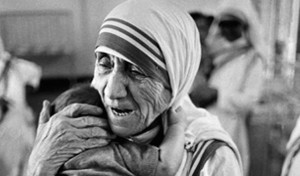Mother Teresa to be made a saint
When Mother Teresa received the Nobel Peace Prize in 1979, she was asked, “What can we do to promote world peace?” She answered “Go home and love your family.”
Building on this theme in her Nobel Lecture, she said: “Around the world, not only in the poor countries, but I found the poverty of the West so much more difficult to remove. When I pick up a person from the street, hungry, I give him a plate of rice, a piece of bread, I have satisfied. I have removed that hunger. But a person that is shut out, that feels unwanted, unloved, terrified, the person that has been thrown out from society””that poverty is so hurtable [sic] and so much, and I find that very difficult.”
She also singled out abortion as “the greatest destroyer of peace today. Because if a mother can kill her own child ”“ what is left for me to kill you and you kill me ”“ there is nothing between.”
Born Agnes Gonxha Bojaxhiu on Aug. 26, 1910, in Skopje, Macedonia, Mother Teresa joined the Loreto order of nuns in 1928. In 1946, while traveling by train from Calcutta to Darjeeling, she was inspired to found the Missionaries of Charity order.
The order was established four years later and has since opened more than 130 houses worldwide to provide comfort and care for the needy, sick and “poorest of the poor.”
She said in 1977, “”The poor give us much more than we give them,”
“They’re such strong people, living day to day with no food. And they never curse, never complain.”
In 1999, a poll of Americans ranked her first in Gallups List of Most Admired People in the world. Not just once she was in the list 18 times and finishing first many times in the top ten admired woman in the world.
Analyzing her deeds and achievements, John Paul II asked: “Where did Mother Teresa find the strength and perseverance to place herself completely at the service of others? She found it in prayer and in the silent contemplation of Jesus Christ, his Holy Face, his Sacred Heart.
At times, seeing the extreme suffering, Mother Teresa expressed grave doubts about God’s existence and pain over her lack of faith:
“Where is my faith? Even deep down … there is nothing but emptiness and darkness … If there be God””please forgive me. When I try to raise my thoughts to Heaven, there is such convicting emptiness that those very thoughts return like sharp knives and hurt my very soul … How painful is this unknown pain””I have no Faith. Repulsed, empty, no faith, no love, no zeal, … What do I labor for? If there be no God, there can be no soul. If there be no soul then, Jesus, You also are not true.”
After Mother Teresa’s death in 1997, the Holy See began the process of beatification, the third step toward possible canonisation. This process requires the documentation of a miracle performed from the intercession of Mother Teresa.
In 2002, the Vatican recognised as a miracle By Mother Teresa the healing of a tumor in the abdomen of an Indian woman, Monica Besra, after the application of a locket containing Mother Teresa’s picture. Besra said that a beam of light emanated from the picture, curing the cancerous tumor. Some of Besra’s medical staff and Besra’s husband said that conventional medical treatment had eradicated the tumor.
The beatification of Mother Teresa took place on 19 October 2003, thereby bestowing on her the title “Blessed.”
On 17 December 2015, the Vatican confirmed that Pope Francis recognised a second miracle attributed to her involving the healing of a Brazilian man with multiple brain tumors.
Vatican has set no date for the canonization, but it is widely believed that it will take place in the first week of September to coincide with the 19th anniversary of Mother Teresa’s death and during Francis’ Holy Year of Mercy.
Short URL: https://indiandownunder.com.au/?p=6008

